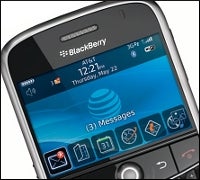 BlackBerry Bold. Click to enlarge. Source: RIM |
The BlackBerry Bold — Research in Motion’s first high-speed 3G device and its next entry in the increasingly competitive smartphone space — is now set to arrive on Nov. 4, six months after its official announcement from its manufacturer.
The smartphone, which had reportedly suffered delays due to problems in network testing by its exclusive carrier, AT&T (NYSE: T), was originally announced prior to the debut of the iPhone 3G from Apple earlier this year.
But Apple beat RIM (NASDAQ: RIMM) to market with its launch in June, after which Apple’s (NASDAQ: AAPL) 3G-enabled, second-generation handset began flying off the shelves. AT&T, which is also the iPhone’s exclusive U.S. carrier, said during its earnings report today that it sold 2.4 million of the devices during the third quarter of 2008.
Apple has also expressed an interest in making inroads in RIM’s home turf, the enterprise. Earlier this year, the company announced business-friendly features like support for Microsoft’s Exchange server and additional initiatives designed to make it appeal to business users and IT administrators.
Meanwhile, the Blackberry Bold has yet to make its debut. While RIM declined to comment on the Bold’s six-month delay, some reports have claimed that the same AT&T network glitches that were earlier thought to have impacted some iPhone 3G users also tripped up the Bold during its network testing and certification process.
For RIM, the stakes are high. While its BlackBerry product is the leading enterprise smartphone, the Canadian handset maker has been pushing hard this year to grab lucrative consumer market share away from devices like Apple’s iPhone while protecting its lead in the workplace. Recent findings indicate the iPhone now commands about 17 percent of the total smartphone market, just two years after its launch.
The quest for users and network subscribers also is intensifying for handset makers and carriers, who are looking ahead to the impending holiday season — a popular product launch time — while struggling to cope with the shaky economic climate impacting both consumer and IT spending.
Priced at $299 with a two-year contract, the Bold is a bit pricier than the iPhone, which is selling for under $200 with a two-year AT&T contract.
Similar to the iPhone, the Bold offers 3G and Wi-Fi network capabilities, according to the carrier — making it the only U.S. BlackBerry device to offer 3G as well as support for both networks. Benefits of 3G network connectivity including simultaneous voice and data service use. AT&T has said it expects to have 3G networks covering nearly 350 leading U.S. markets by the end of 2008, including all of the 100 largest cities.
The Bold also features a full QWERTY keyboard and offers more storage memory than previous BlackBerry models, with 1 gigabyte (GB) of memory built-in and another 16GB available with a SD memory card. In addition, the unit has a 624MHz mobile processor for faster document downloading, and is compatible with 3G networks globally, with support for GSM
In a statement, RIM officials called the Bold “an ambitious undertaking.”
“We focused intensely on the things that are most important to mobile customers. It provides an extraordinary mobile communications and multimedia experience,” Mike Lazaridis, RIM’s president and co-CEO, said in a statement.
RIM hasn’t necessarily been sitting still while waiting for the Bold to get the thumbs-up from AT&T. The company has pushed out the Pearl Flip 8220, Storm 9730 and Curve this year.
“It’s all about choice and AT&T provides its customers with the broadest choice of smartphones,” John Kampfe, director of media and industry analyst relations at AT&T, told InternetNews.com.


